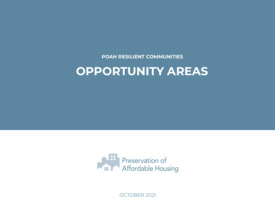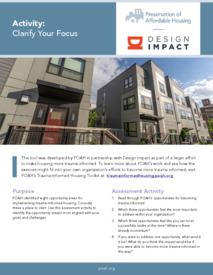Helpful Tools
Policies, Programs and People: Opportunities for Housers
-
Encourage Community Care: Communities of support help us deal with challenges and support our resilience. When we invest time and resources into community care, we can reduce requests to frontline staff (who are already stretched) and strengthen resident leadership and autonomy.
-
Redefine Leadership: Residents and frontline staff are often caught in a system where they don’t have power over decisions that affect them. Despite their expertise, skills and valuable perspectives, they are often disconnected from the entities that make decisions on their behalf. And when we don’t have agency or trust, it’s easy to slip up.
-
Strengthen Workplace Collaboration: Property Management and Resident Services staff have the same goal: safe, quality places for residents to live. But our roles, responsibilities and even physical surroundings can create tension. When we work on teams with seemingly opposing views, we miss opportunities to collaborate and lessen our workloads. This makes work more stressful and takes time and energy away from serving residents.
-
Organizational Support for Burnout: The housing system places unreasonable expectations on frontline staff to serve residents while also serving funders, regulators and other stakeholders. When we are running on empty tanks, we cannot adequately serve residents, let alone show up with compassion or empathy for others. And too often, avoiding burnout falls on us.
-
Prioritize Healing: Frontline staff and residents are experiencing trauma inside and outside of their jobs and homes. Recognizing that we all experience trauma is important, but without proper support and resources to address underlying issues, we may continue to inflict harm on one another.
-
Address Community Trauma: Trauma doesn’t just stem from inside of housing, but what’s going on outside as well – neighborhood violence, gentrification and poverty can all be traumatic to us. And that trauma affects how we interact with each other, how we respond to issues, and even how we see the owner or management company. Housing providers may not be responsible for trauma, but they are institutions that can continue the cycle of trauma, or help disrupt it.
-
Communicate with Dignity & Belonging: Housing can send certain message through space, signage and rules, like “You are welcome. You belong.” Or “There’s an entire waiting list that could replace you. We don’t trust you. This place is not meant for you.” Messages that don’t fully communicate our dignity or honor us as humans can retraumatize us.
-
Design Trauma-Informed Spaces: The physical environment can impact our attitude, mood, health and well-being. Spaces that are poorly lit or closed off from the surrounding area can trigger past trauma or contribute to stress. Spaces that are warm, bright and flexible can promote a sense of safety and calm.




